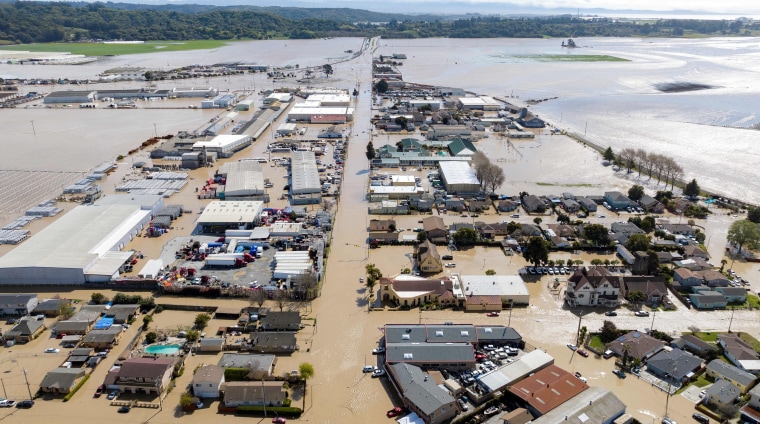A second atmospheric river is on its way to California, just as the state contends with a levee breach, evacuations and other damage from this week's winter storm.
The next atmospheric river — a long, narrow band of moisture drawn from the tropics — is forecast for Monday, and could be more powerful than the last.
California has been inundated by the latest front. In Oroville, north of Sacramento, a swift water rescue team helped two people stranded on an island in the Feather River get to safety. In the Central Coast, river flooding in Atascadero and Paso Robles was widely feared.
Residents of parts of Monterey County woke up to urgent flood warnings and orders to move out after a levee was breached around midnight by the rain-swollen waters of the Pajaro River, county officials said.
California National Guard troops and Monterey County sheriff's and fire first responders helped residents in flooded neighborhoods evacuate to higher ground Saturday.
An area firefighter was injured by a falling tree, they said. Details were not provided about the person’s condition and where the injury occurred.
More than 90 rescues were completed since Friday, with as many as 20 by boat, Monterey County officials said at an afternoon news conference.
County Board of Supervisors Chair Luis Alejo said the river-adjacent town of Pajaro, with a population of 1,700, was left in 1 to 3 feet of standing water and estimated that recovery and repairs for area homes could take months.
No deaths were reported.

Alejo said it was unlikely the levee would be fully repaired before the next storm hits the area Monday night.
"We're very much worried about the second storm coming," he said.
The county on Saturday issued an alert for customers of the Pajaro Sunny Mesa Water District warning them not to drink the tap water or use it in food preparation because local wells had been flooded during the storm.
Another Monterey County community, Arroyo Seco, remained under mandatory evacuation Saturday after a main road was washed out the Friday by the storm, county officials said.
Nearly 18,000 utility customers in the county were without power Saturday, according to grid tracking site poweroutage.us.
Other parts of the state were affected by the extreme weather, including Santa Cruz County, where local government officials released video and photos of flood damage in the community of Soquel.
Further south, evacuation orders for parts of San Luis Obispo County were lifted Saturday, but some neighborhoods remained under evacuation warnings.
The cities of San Luis Obispo and Morro Bay declared local emergencies in response to the extreme weather.
"City officials and staff are preparing for a series of two atmospheric river storms forecasted to bring multiple inches of rain each to San Luis Obispo," that city said in a statement.
On Friday, officials in Kern County put low-lying areas of the communities of Riverkern and Kernville under evacuation orders amid forecasts of flooding.
In Southern California, the Ventura County Fire Department said Saturday a sinkhole measuring 30 by 300 feet appeared between two homes in the city of Camarillo.
President Joe Biden on Thursday declared a federal emergency to help expedite disaster relief.
The weather service said in a forecast discussion that the Bay Area and Central Coast were in the path for the next front, which it described as likely more intense and more loaded with precipitation.
“This event will be more widespread,” Meteorologist Kristan Lund of the National Weather Service’s Oxnard office said.
A scale for atmospheric rivers, developed by scientists at the Scripps Institution of Oceanography, measured the weekend storm at its weakest level, AR 1. Monday's storm is forecast to reach an intensity and duration of AR 3, said to represent a storm both "beneficial and hazardous."
Atmospheric rivers have helped Los Angeles record nearly 21 inches of rain since the season began Oct. 1, surpassing the average year’s 14.77 inches. It’s not yet clear if Los Angeles and points south will be significantly impacted by the next atmospheric river.
